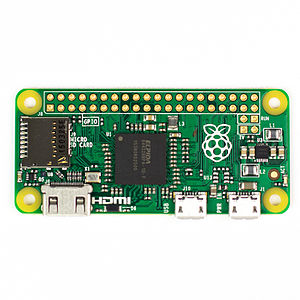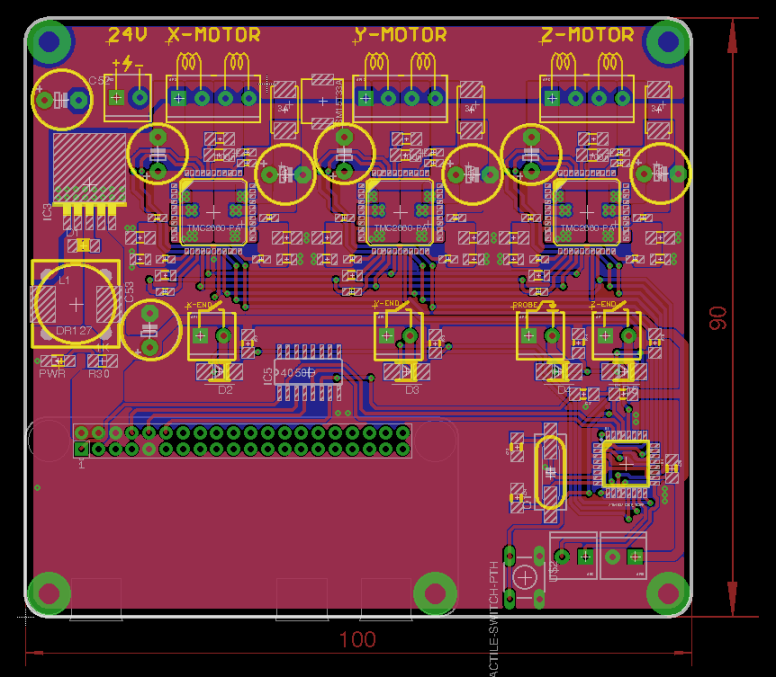So, yesterday the Raspberry Pi Foundation, released a new Pi! The Pi Zero!

So what happens when I am bored, sitting in a guesthouse, armed with Eagle, a crazy idea, a community encouraging me, and a handful of parts in my parts bin just itching to be used? Mixed in with a passion for CNC? Yip exactly that what you were just thinking!
Couple of points to plan in…
USB Hub
So, first off: USB. The Pi Zero is great right? Except it doesnt come with proper USB Ports ): Sucks right?
So first problem I want to tackle is a board on top, or on the size, with a 4 port USB hub. To connect to the Pi Zero, instead of a small cable, I want to have a small PCB soldered on at 90 deg to the main board, holding a PCB mount USB Micro socket: I just received a few hundred of these from Aliexpress a few weeks back….

This allows a clean, slot on adapter – no messy wires.
Next, for the USB circuit, I will go with my old trusty building block circuit, the TI TUSB2046: (already open sourced it on my Github, here: https://github.com/openhardwarecoza/OPBS-PROJECT_ALPHA/tree/master/Research/Modular%20Tests/USB-Hub)
Grbl and TinyG – yes both
So what else does a RPI ZERO CNC CONTROLLER need? Grbl! The old easy favourite, although, John Lauer of http://chilipeppr.com/tinyg just asked me on Google Plus (thread on https://plus.google.com/+PetervanderWalt/posts/dtGv42CSVxV) if I can make it work with TinyG too and I said, sure, why not! So two versions in the pipeline!
High powered Stepper Driver stage
I’m going to need a good stepper driver setup. And again, I already have a building block in my github from a design I was working on before the Zero came out: The TMC2660, capable of 4A per motor, 256 microstep! https://github.com/openhardwarecoza/OPBS-PROJECT_ALPHA/tree/master/Research/Modular%20Tests/Stepper%20Drivers
Wifi
So what about the lack of networking on the Pi Zero? Well I am already working in a USB Hub, I wonder if I can add a USB Wifi Adapter. But lets make it super cool and add a footprint for one of these: http://www.aliexpress.com/item/wifi-module-RTL8188EUS-RTL8188-NEW-ORIGINAL-2PCS-LOT/32240202795.html?spm=2114.031010208.3.20.STJZAx&ws_ab_test=searchweb201556_6_79_78_77_80,searchweb201644_5,searchweb201560_8 – a surface mountable Realtek Wifi NIC module?
PCB Design coming this Sunday!
I will post up preliminary board design by Sunday (On the road today and tomorrow, so being brief with this post to get it done rather quickly, instead of blogging…) – in the meantime, as always, I will open source the whole thing, including BOM so you can go ahead and make it for yourself or some friends. If you sell it, just remember you owe me some beer (:
If you would like to help with paying the prototyping costs, you can shoot me a donation on Paypal if you wish:
https://www.paypal.com/cgi-bin/webscr?cmd=_s-xclick&hosted_button_id=KC92Q2BJL4S7U&source=url – would be great since I need to order those USB Wifi modules, some TMC2660s, and a Pi Zero (;
#cnc, #grbl, #pi, #raspberry, #tinyg, #zero








